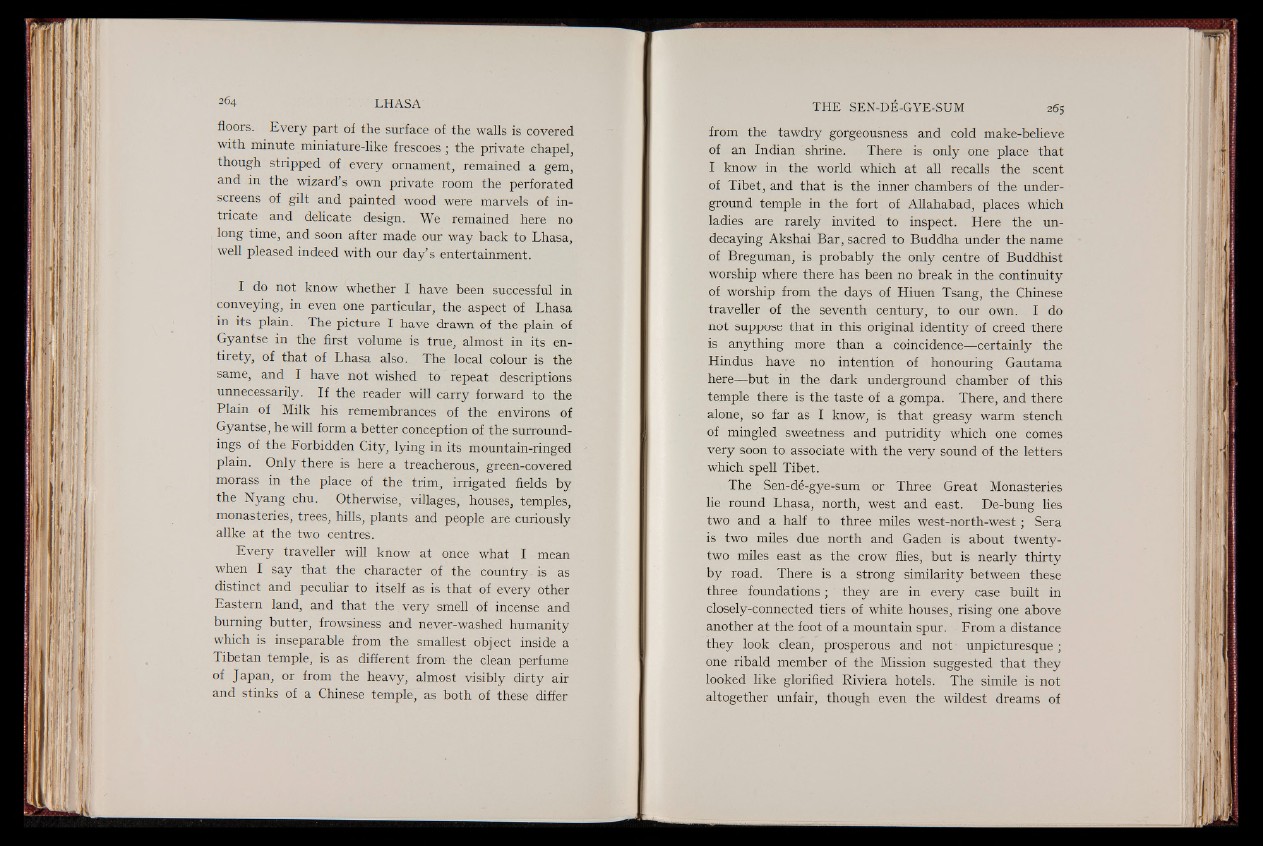
floors. Every part of the surface of the walls is covered
with minute miniature-like frescoes ; the private chapel,
though stripped of every ornament, remained a gem,
and in the wizard’s own private room the perforated
screens of gilt and painted wood were marvels of intricate
and delicate design. We remained here no
long time, and soon after made our way back to Lhasa,
well pleased indeed with our day’ s entertainment.
I do not know whether I have been successful in
conveying, in even one particular, the aspect of Lhasa
in its plain. The picture I have drawn of the plain of
Gyantse in the first volume is true, almost in its entirety,
of that of Lhasa also. The local colour is the
same, and I have not wished to repeat descriptions
unnecessarily. If the reader will carry forward to the
Plain of Milk his remembrances of the environs of
Gyantse, he will form a better conception of the surroundings
of the Forbidden City, lying in its mountain-ringed
plain. Only there is here a treacherous, green-covered
morass in the place of the trim, irrigated fields by
the Nyang chu. Otherwise, villages, houses, temples,
monasteries, trees, hills, plants and people are curiously
alike at the two centres.
Every traveller will know at once what I mean
when I say that the character of the country is as
distinct and peculiar to itself as is that of every other
Eastern land, and that the very smell of incense and
burning butter, frowsiness and never-washed humanity
which is inseparable from the smallest object inside a
Tibetan temple, is as different from the clean perfume
of Japan, or from the heavy, almost visibly dirty air
and stinks of a Chinese temple, as both of these differ
from the tawdry gorgeousness and cold make-believe
of an Indian shrine. There is only one place that
I know in the world which at all recalls the scent
of Tibet, and that is the inner chambers of the underground
temple in the fort of Allahabad, places which
ladies are rarely invited to inspect. Here the un-
decaying Akshai Bar, sacred to Buddha under the name
of Breguman, is probably the only centre of Buddhist
worship where there has been no break in the continuity
of worship from the days of Hiuen Tsang, the Chinese
traveller of the seventh century, to our own. I do
not suppose that in this original identity of creed there
is anything more than a coincidence— certainly the
Hindus have no intention of honouring Gautama
here— but in the dark underground chamber of this
temple there is the taste of a gompa. There, and there
alone, so far as I know, is that greasy warm stench
of mingled sweetness and putridity which one comes
very soon to associate with the very sound of the letters
which spell Tibet.
The Sen-de-gye-sum or Three Great Monasteries
lie round Lhasa, north, west and east. De-bung lies
two and a half to three miles west-north-west; Sera
is two miles due north and Gaden is about twenty-
two miles east as the crow flies, but is nearly thirty
by road. There is a strong similarity between these
three foundations; they are in every case built in
closely-connected tiers of white houses, rising one above
another at the foot of a mountain spur. From a distance
they look clean, prosperous and not unpicturesque ;
one ribald member of the Mission suggested that they
looked like glorified Riviera hotels. The simile is not
altogether unfair, though even the wildest dreams of